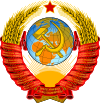Lunokhod programme

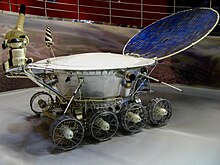
Lunokhod(Russian:Луноход,IPA:[lʊnɐˈxot],"Moonwalker" ) was a series ofSovietroboticlunar roversdesigned toland on the Moonbetween 1969 and 1977. Lunokhod 1 was the first roving remote-controlled robot to land on an extraterrestrial body.
The 1969 Lunokhod 1A (Lunokhod 0, Lunokhod No. 201) was destroyed during launch, the 1970Lunokhod 1and the 1973Lunokhod 2landed on the Moon, andLunokhod 3(Lunokhod No. 205, planned for 1977) was never launched. The successful missions were in operation concurrently with theZondandLunaseries of Moon flyby,orbiterand landing missions.
The Lunokhods were primarily designed to support theSoviet human Moon missionsduring theMoon race.Instead, they were used as remote-controlledrobotsfor exploration of the lunar surface and returning pictures, after theApollohuman lunar landings and cancellation of the Soviet human Moon programme.
The Lunokhods were transported to the lunar surface byLunaspacecraft, which were launched byProton-Krockets.
Development[edit]
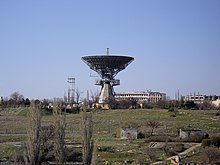
Lunokhod's original primary mission was to be the back-up forL3 crewed Moon expeditionsand for the laterZvezdalunar base.[citation needed]For mission safety, weeks before the human mission on aLK lander,an LK-R uncrewed lander from the L3 lunar expedition complex and two Lunokhod automated rovers would be sent to the Moon for a preliminary study of the surface around LK-R and LK sites, to act as radio beacons for precision landings of LK-R and LK, and for a visual evaluation of the status of the site.[1]
In mid-1968, at the facility KIP-10 or NIP-10 (КИП-10 or НИП-10, located at45°03′10″N33°53′25″E/ 45.052703°N 33.890256°E)[2]in theclosed townShkolnoye (Simferopol-28),nearSimferopol,Crimea,a lunodrom (лунодром - Moondrome, located at45°03′15″N33°53′37″E/ 45.054212°N 33.893627°E) was built. It covered an area of one hectare (120 meters by 70 meters) and was very similar to some parts of the lunar surface. It was constructed using more than 3,000 cubic meters of soil, and included 54 craters up to 16 m in diameter and around about 160 rocks of various sizes.[3]The whole area was surrounded with bricks, painted in gray and black. It was used to analyze problems with the Lunokhod chassis and cosmonaut's skill to control one.[4][5]
Closed town Simferopol-28 contained the most significant tracking facility in the Soviet Union, having the largest number of antennas, the largest area, and the most personnel of any of the Soviet tracking facilities. The facility was one of a network of ten facilities which contain earth satellite vehicle tracking equipment and provide command/control for Soviet near-space civil and military events. Additionally, this facility supportedall lunar programmesof the Soviet Union, in association with theEvpatoria Deep Space Tracking Facility.[6][7]
At least four complete vehicles were constructed, with the serial numbers 201, 203, 204 and 205.[citation needed]
Rover design[edit]
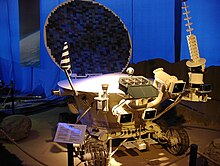

The Lunokhod rovers were lunar vehicles formed of a tub-like compartment with a large convex lid on eight independently-powered wheels. They were equipped with a cone-shaped antenna, a highly directionalhelical antenna,television cameras,and special extendable devices to impact the lunar soil for density measurements and mechanical property tests, plus a scientific payload which varied with the mission.
The Lunokhods were designed under the leadership ofGeorgy Babakin[8]atLavochkindesign bureau. The metal chassis themselves were designed byAlexander Kemurdzhian.
The vehicles were powered bybatteries.The rover ran during the lunar day, stopping occasionally to recharge its batteries using its solar panels. The power was supplied during the lunar day by a GaAs solar array on the inside of a round hinged lid which covered the instrument bay, which would charge the batteries when opened. During the lunar nights, the lid was closed and apolonium-210radioisotope heater unitkept the internal components atoperating temperature.[9]
To be able to work in a vacuum a special fluoride-basedlubricantwas used for the rover's mechanical parts, and the electric motors, one in each wheel hub, were enclosed in pressurised containers.[10][11]
The rovers stood 135 centimetres (4 feet 5 inches) high and had a mass of 840 kg (1,850 lb). It was about 170 centimetres (5 feet 7 inches) long and 160 centimetres (5 feet 3 inches) wide and had eight wheels each with an independent suspension, motor and brake. The rover had two speeds, approximately 1 and 2 km/h (0.6 and 1.2 mph).
The Lunokhods were transported to the lunar surface byLunaspacecraft, which were launched byProton-Krockets. The Moon lander part of the Luna spacecraft for Lunokhods was similar to the one forsample-return missions.
Lunokhod Rovers[edit]
Lunokhod 201[edit]
After years of secret engineering development and training, the first Lunokhod (vehicle 8ЕЛ№201) was launched on February 19, 1969. Within a few seconds the rocket disintegrated and the first Lunokhod was lost. The rest of the world did not learn of the rocket's valuable payload until years later.[12]The failure resulted in the radioactive heat source,polonium 210,being spread over a large region of Russia.[13]
Lunokhod 1[edit]
This sectionneeds additional citations forverification.(April 2019) |
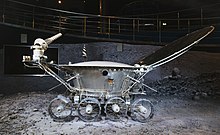

After the destruction of the original Lunokhod, Soviet engineers began work immediately on another lunar vehicle.Lunokhod 1(vehicle 8ЕЛ№203) was the first of two uncrewed lunar rovers successfully landed on the Moon by the Soviet Union as part of its Lunokhod programme. The spacecraft which carriedLunokhod 1was namedLuna 17.Lunokhod 1was the first roving remote-controlled robot to land on another world.
Luna 17was launched on November 10, 1970 at 14:44:01 UTC. After reaching Earthparking orbit,the final stage ofLuna 17's launching rocket fired to place it into a trajectory towards the Moon (November 10, 1970 at 14:54 UTC). After two course correction manoeuvres (on November 12 and 14) it entered lunar orbit on November 15, 1970 at 22:00 UTC.
The spacecraft soft-landed on the Moon in theSea of Rainson November 17, 1970 at 03:47 UTC. The lander had dual ramps from which the payload,Lunokhod 1,could descend to the surface. At 06:28 UT the rover moved down the ramps and onto the Moon.
The rover's payload included cameras (two television and four panoramic telephotometers), a RIFMAX-ray fluorescence spectrometer,an RT-1X-ray telescope,a PrOP odometer/penetrometer, a RV-2N radiation detector, and a TL laser retroreflector.[14]
An urban legend was spread among the Soviet Union that the Lunokhod rover was driven by a “KGBDwarf”,[15]however it was never explained how supplies were stored to keep them alive for an 11-month mission.
Lunokhod 2[edit]
This sectionneeds additional citations forverification.(April 2019) |

Lunokhod 2(vehicle 8ЕЛ№204) was the second and more advanced of the two Lunokhod rovers. The launcher put the spacecraft into Earth parking orbit on January 8, 1973, followed by atranslunar injection.On January 12, 1973,Luna 21was braked into a 90 by 100 km (56 by 62 miles)lunar orbit.
TheLuna 21spacecraft landed on the Moon to deploy the second Soviet lunar rover,Lunokhod 2.The primary objectives of the mission were to collect images of the lunar surface, examine ambient light levels to determine the feasibility of astronomical observations from the Moon, perform laser ranging experiments from Earth, observe solar X-rays, measure local magnetic fields, and study mechanical properties of the lunar surface material.
The landing occurred on January 15, 1973 at 23:35 UT inLe Monnier crater(25.85 degrees N, 30.45 degrees E).
After landing theLunokhod 2took television images of the surrounding area, then rolled down a ramp to the surface at 01:14 UT on 1973-01-16. It then took pictures of theLuna 21lander and landing site.
The rover was equipped with threeslow-scan televisioncameras, one mounted high on the rover for navigation, which could return high resolution images at different rates—3.2, 5.7, 10.9 or 21.1 seconds per frame (not frames per second). These images were used by the five-man team of controllers on Earth who sent driving commands to the rover in real time.[16]There were four panoramic cameras mounted on the rover.
Scientific instruments included asoil mechanicstester, solar X-ray experiment, anastrophotometerto measure visible andultravioletlight levels, amagnetometerdeployed in front of the rover on the end of a 2.5m(8 ft 2 in) boom, aradiometer,aphotodetector(Rubin-1) for laser detection experiments, and a French-supplied lasercorner reflector.
Payload[edit]
- Cameras (three television and four panoramictelephotometers)
- RIFMA-MX-ray fluorescencespectrometer
- X-ray telescope
- PROPodometer/penetrometer
- RV-2N-LSradiation detector
- TL laserretroreflector
- AF-3L UV/visibleastrophotometer
- SG-70Amagnetometer
- Rubin 1photodetector
Lunokhod 3[edit]


Lunokhod 3(vehicle 8ЕЛ№205) was built for aMoon landingin 1977 asLuna 25,[17]but never flew to the Moon due to lack of launchers and funding. It remains at the NPO Lavochkin museum.[18]
Results[edit]
During its 322 Earth days of operations,Lunokhod 1travelled 10.5 km (6.5 miles) and returned more than 20,000 television images and 206 high-resolution panoramas.[19]In addition, it performed twenty-five soil analyses with its RIFMA x-ray fluorescence spectrometer and used its penetrometer at 500 different locations.
Lunokhod 2operated for about four months, covered 42 km (26 miles) of terrain,[20]including driving into hilly upland areas andrilles.Lunokhod 2held the record for the longest distance of surface travel of any extraterrestrial vehicle until 2014.[12]It sent back 86 panoramic images and over 80,000 television pictures. Many mechanical tests of the Moon's surface,laser rangingmeasurements, and other experiments were completed during this time.
In 2010, nearly forty years after the 1971 loss of signal fromLunokhod 1,theNASALunar Reconnaissance Orbiterphotographed its tracks and final location, and researchers, using a telescopic pulsed-laser rangefinder, detected the robot'sretroreflector.[21]
Not untilMars Pathfinder's deployment of the "Sojourner"Rover in 1997 was another remote-controlled vehicle put on an extraterrestrial body. For comparison, the similarly sized NASAMars Exploration Rovers,SpiritandOpportunityhad, by their fifth anniversary in January 2009, traveled a total of 21 km (13 miles) and transmitted over 125,000 images.[22]
Chernobyl legacy[edit]
According to a French documentary television filmTank on the Moonby Jean Afanassieff, the Lunokhod design returned to the limelight 15 years later due to theChernobyl nuclear power plant disasteron April 26, 1986.[23]TheEast German-built remote controlledbulldozersavailable to Sovietcivil defensetroops weighed dozens of tons – too heavy to operate on the remaining parts of the partially collapsed reactor building roof. Human labourers could not be employed to shovel debris since work shifts were limited to 90-second intervals due to intenseionizing radiation.[24]
Lunokhod designers were called back from retirement, and in two weeks rovers were made which usednuclear decayheat sources for internal rack climate control, their electronic systems were already hardened to partly resist radiation.[23]This benefit allowed the 1986 designers to quickly devise a derived vehicle type for nuclear disaster recovery work. On July 15, two rovers, called STR-1,[12]were delivered to the Chernobyl accident zone and proved useful for clearing debris, earning awards for the designers. Due to extremely high radiation levels, both STR-1 rovers eventually failed, and human workers (later namedliquidators) were called in once again.[23][25]
Locations and ownership[edit]
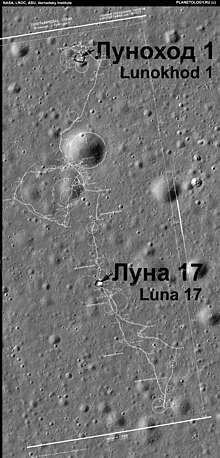
Until 2010, the final location ofLunokhod 1was uncertain by a few kilometers.[26]Lunar laser ranging experimentshad failed to detect a return signal from its retroreflector since the 1970s.[27]On March 17, 2010, Albert Abdrakhimov found both the lander and the rover[28]inLunar Reconnaissance Orbiterimage M114185541RC.[29]On April 22, Tom Murphy (UCSD) and Russet McMillan at theApache Point Observatorydetected the robot's retroreflector using the Apache Point telescopic pulsed-laser rangefinder.[21]
Lunokhod 2continues to be detected bylunar laser ranging experimentsand its position is known to sub-metre accuracy. Ownership ofLunokhod 2and theLuna 21lander was sold by theLavochkinAssociation forUS$68,500in December 1993 at aSotheby'sauction in New York[30](although the catalogue incorrectly lists lot 68A asLuna 17/Lunokhod 1).[31]The buyer was computer gaming entrepreneur and astronaut's sonRichard Garriott,who is also known by the name of his gaming characterLord British.Garriott stated in a 2001 interview: "I purchasedLunakod 21[sic] from the Russians. I am now the world's only private owner of an object on a foreign celestial body. Though there are international treaties that say no government shall lay claim to geography off planet earth, I am not a government. Summarily, I claim the Moon in the name ofLord British!"[32]In 2007, Garriott said he is still the owner ofLunokhod 2.[33][34]
See also[edit]
References[edit]
- ^"Soyuz 7K-LOK".astronautix.Retrieved2022-11-07.
- ^"10.7 Луноходы Симф".kik-sssr.ru.Archived fromthe originalon 2021-10-27.Retrieved2015-07-27.
- ^"NIP-10 Simferopol Near Earth Satellite Center, The Lunokhod Moon Drome".flickr.30 August 2011.
- ^Космическая энциклопедия(in Russian). September 18, 2008.
- ^"Panoramio is no longer available".panoramio.Archived fromthe originalon 2017-09-28.Retrieved2017-10-27.
- ^NATIONAL PHOTOGRAPHIC INTERPRETATION CENTER June 1969SIMFEROPOL SPACEFLIGHT CENTER
- ^"Infinity Beckoned by Jay Gallentine".Archived fromthe originalon September 4, 2015.
- ^"Lunochod's chief designer is dead".Cosmic Mirror. March 6, 2003. Archived fromthe originalon May 1, 2003.
- ^Blair, Sean (March 14, 2011). "Rovers learning from Lunokhod",E&T News.Retrieved 23 June 2022.
- ^"Den ryska månbilen".Vetenskapens värld(in Swedish). 11 February 2008.SVT2.Archived fromthe originalon 2 June 2008.Retrieved11 February2008.
- ^"Moon applications".Synlube Lube-4-Life.
- ^abc"Tank on the Moon".The Nature of Things with David Suzuki.December 6, 2007. CBC-TV. Archived fromthe originalon December 26, 2008.
- ^Karacalıoğlu, Göktuğ (January 6, 2014)."Energy Resources for Space Missions".Space Safety Magazine.RetrievedJanuary 18,2014.
- ^"In Depth | Luna 17".NASA Solar System Exploration.Archived fromthe originalon 2022-06-29.Retrieved2022-06-29.
- ^"KGB Dwarf".astronautix.Retrieved2022-06-26.
- ^"Экипажи Лунохода".astronaut.ru.
- ^Harvey, Brian (17 August 2007).Soviet and Russian Lunar Exploration.Springer. p. 280.ISBN9780387218960.Retrieved2014-04-20.
- ^Chaikin, Andy (February–March 2004)."The Other Moon Landings".Air & Space.Archived fromthe originalon 2014-05-11.
- ^"Lunokhod 1 Panoramas".planetology.ru.RetrievedApril 30,2013.
- ^Wall, Mike (July 11, 2013)."NASA Moon Probe Helps Revise Off-Planet Driving Record | Lunokhod 2".Space.RetrievedJuly 12,2013.
- ^abBleicher, Ariel (August 2010)."Forgotten Soviet Moon Rover Beams Light Back to Earth".IEEE Spectrum.Archived fromthe originalon 2011-08-20.Retrieved2011-05-28.
- ^"Public Events Mark Mars Rovers' Five-Year Anniversary"(Press release). Jet Propulsion Laboratory. January 12, 2009. Archived fromthe originalon May 9, 2009.RetrievedApril 26,2009.
- ^abcZarowny, Andrew (March 16, 2011)."Lunokhod: From the Moon to Chernobyl, the Little Robot That Could!".Right Pundits.Archived fromthe originalon March 18, 2011.RetrievedJune 21,2016.
- ^McDougal, Heather (February 19, 2009)."Lunokhod and the Art of Space".Cabinet of Wonders.RetrievedJune 21,2016.
- ^Anderson, Christopher (January 20, 1990)."Soviet Official Admits That Robots Couldn't Handle Chernobyl Cleanup".The Scientist.Canada.RetrievedJune 21,2016.
- ^Stooke, P.J. (2005).Lunar laser ranging and the location of Lunokhod 1(PDF).Lunar & Planetary Science XXXVI.
- ^David, Leonard (March 27, 2006)."Lunar Lost & Found: The Search for Old Spacecraft".SPACE.
- ^Lakdawalla, Emily (March 17, 2010)."And now for Luna 17 and Lunokhod 1".Planetary Report. Archived fromthe originalon March 18, 2012.RetrievedApril 12,2010.
- ^"LROC Observation M114185541R".Arizona State University.
- ^Kluger, Jeffrey (April 1994)."The Bloc on the Block".Discover Magazine.
- ^Sotheby's Catalogue -Russian Space History,Addendum, Lot 68A, December 11, 1993
- ^Yans, Cindy (April 13, 2001)."Lord British, we hardly knew ye".Computer Games Magazine.via Demiurg.net.
- ^"The Astronaut's Son's Secret Sputnik".CollectSPACE. October 2, 2007.
- ^Garriott, Owen (December 10, 2007)."Sputnik: 50 Years, One Month, Two Weeks Later".Are We Alone(Interview). Interviewed by Seth Shostak. SETI Institute.
Further reading[edit]
- Vinogradov, A. P., ed. (1971).Peredvizhnaya Laboratoriya na Lune Lunokhod-1. Tom 1(in Russian). Moscow: Nauka.
- Barsukov, V. L., ed. (1978).Peredvizhnaya Laboratoriya na Lune Lunokhod-1. Tom 2(in Russian). Moscow: Nauka.
External links[edit]
- Lunar and Planetary Department Moscow University
- Exploring the Moon (1969-1976)- a diary of significant events in Soviet lunar exploration, including those associated with the Lunokhod programme
- Don P. Mitchell's catalog of Soviet Moon Imagesincluding many from the Lunokhod programme
- Remote control lunokhods and planetroversArchived2020-08-12 at theWayback Machine(in Russian)
- Details of the cameras used in the Lunokhods(about halfway down the page, or search the page for "Lunokhod" )

